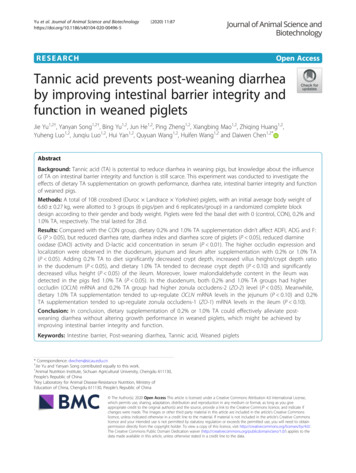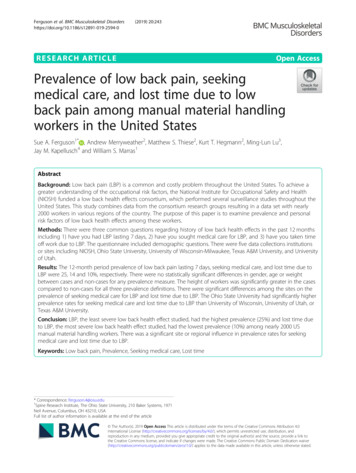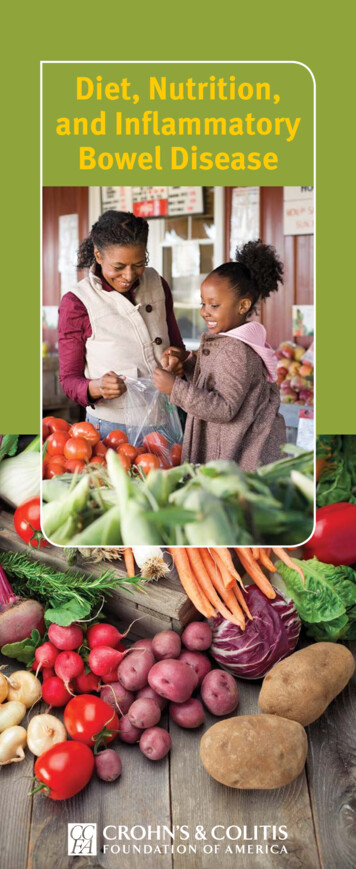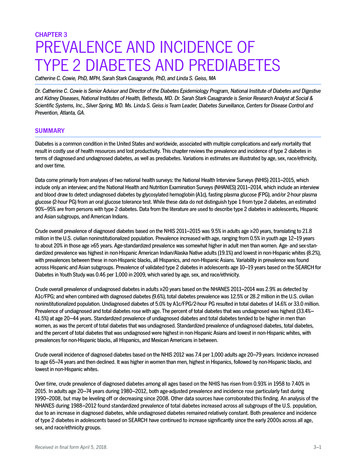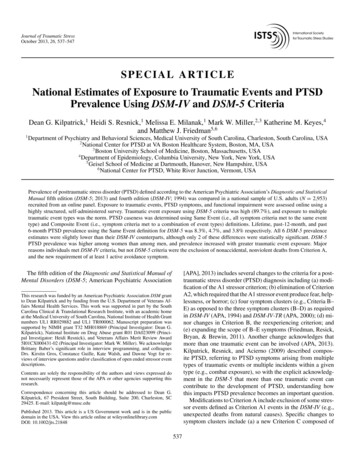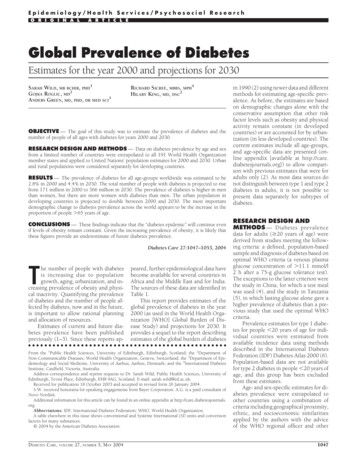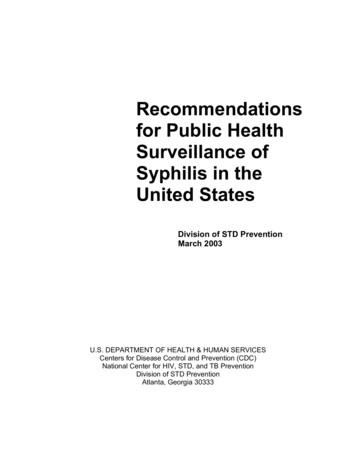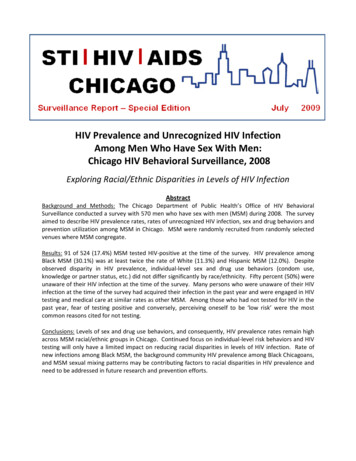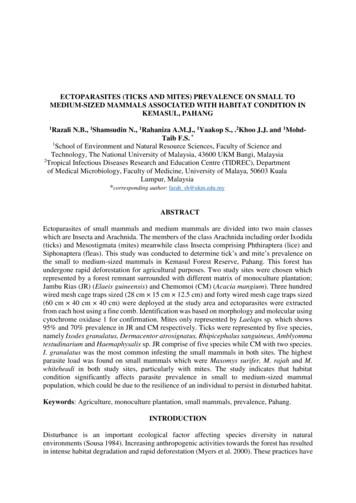
Transcription
Prevalence of Diarrhea and Associated Risk Factors in ChildrenUnder Five Years of Age in Northern Nigeria: A Secondary DataAnalysis of Nigeria Demographic and Health Survey 2013.Degree Project in International HealthDepartment of International Maternal and Child Health, IMCHHanaa HusseinMay 2017Supervisors: Andreas Mårtensson, Carina KällestålWord count: 10,757
AbstractBackgroundDiarrhea is the second leading cause of under five child mortality worldwide afterpneumonia. Daily, Nigeria loses about 2,300 under-fives ranking the country as thesecond largest contributor to the under five mortality rate from diarrhea. The absence ofclean water, essential sanitation and hygiene is responsible for almost 88% of the diseaseburden in the country.AimThis study aimed to identify the risk factors for the occurrence of childhood diarrheaamong children aged between 0-5 years in northern Nigeria regions.MethodDemographic and health survey (DHS) data of Nigeria 2013 was used for this study. Datawas analyzed from the three northern Nigeria regions: Western, Eastern, and Central. Thestudy population was under five children who were residents in the households during thesurvey. Bivariate and multivariate logistic regression was computed to assessindependent factors of childhood diarrhea.ResultsThe prevalence of diarrhea in a two weeks period among under five children in thenorthern regions was 12.7 %. The results of this study showed that maternal education,religion, age, working status, unprotected water source, main floor material, DPT3 andpolio3 vaccination were found to be positively associated risk factors for childhooddiarrhea after adjusting for other variables.ConclusionThe results of this study have critical policy implications for health interventionprograms and emphasize that promoting women education levels and the delivery ofimproved sanitation and hygiene through efficient educational programs may have asignificant importance on the child health and survival in Nigeria.1
2
AcknowledgmentsI would like to thank my professors Carina Källestål and Andreas Mårtensson for all the helpand supervision they have provided during the course to finish the thesis.Also, I would like to thank my parents and my family for their support and encouragementthroughout the last two years of my masters program.Finally, special thanks to my husband Mohammed for his support through the hard times tomake this achievable.3
Table of ContentsAbstract . 1Acknowledgments . 3Abbreviations . 6List of tables . 7List of figures . 81. Introduction . 91.1 Background Information . 91.2 Sanitation, Hygiene and Diarrhea . 101.3 Health Systems in Nigeria . 121.4 Rationale of the Study . 131.4.1 Research Question . 141.4.2 Aim . 141.4.3 Specific Objectives . 141.4.4 Inclusion Criteria . 141.5 Conceptual Framework . 142. Methods . 162.1 Study Design . 162.2 Study Setting . 162.3 Study Population . 172.4 Sampling . 172.4.1 Sampling Design and Implementation . 172.4.2 Data Collection . 182.5 Methods and Variables. 182.5.1 The outcome Variable . 182.5.2 Predictor Variables . 192.6 Statistical Analysis . 202.6.1 Data Cleaning and Variable Management . 202.6.2 Statistical Methods . 212.6.3 Missing Values . 212.6.4 Bias . 223. Ethical Considerations . 224. Results . 234
4.1 Flow of Participants . 234.2 Characteristics of Study Participants . 244.3 Characteristics of Households . 254.3.1 Environmental Conditions . 264.3.2 Behavioral Conditions . 274.4 Prevalence of Diarrhea . 294.5 Risk Factors Associated to Childhood Diarrhea . 294.5.1 Socioeconomic Risk Factors . 294.5.2 Environmental Risk Factors . 314.5.3 Behavioral Risk Factors . 334.6 Multivariable Analysis . 334.6.1 Model I . 334.6.2 Model II . 344.6.3 Model III . 355. Discussion . 385.1 Main Findings . 385.2 Study Findings in Relation to Other Studies . 395.2.1 Mother’s Age . 405.2.2 Mother’s Education . 405.2.3 Mother’s Work Status . 405.2.4 Mother’s Religion . 415.2.5 Source of Drinking Water . 415.2.6 Main Floor Material . 425.2.7 DPT 3 Vaccination . 425.2.8 Polio 3Vaccination . 435.2.9 Non Significant Predictor Variables . 435.3 Study Findings in Relation to Conceptual Framework . 445.4 Strengths and Limitations . 455.4.1 Strengths of the Study . 455.4.2 Limitations of the Study. 455.4.3 Internal Validity . 465.4.4 External Validity . 465.5 Public Health Relevance . 465.6 Conclusion . 475
References . 49Annex . 52AbbreviationsWHOWorld Health OrganizationU5MRUnder Five Mortality RateMDG4Millennium Development Goal 4SDGSustainable Development GoalWASHWater, Sanitation and HygieneLGALocal Government TiersGAPPDGlobal Action Plan for the Prevention and Control of Pneumonia and DiarrheaNDHSNigeria Demographic and Health SurveyEAsEnumeration AreasPSUPrimary Sampling UnitDPTDiphtheria, Pertussis, TetanusCORCrude Odds RatiosAORAdjusted Odds RatiosCIConfidence IntervalsVIFVariance Inflation FactorNANot ApplicableCFRCode of Federal RegulationsLICLow Income Countries6
List of TablesTable 1:Frequency and Percentage Distribution of the Mother’s Characteristics in NorthernNigeria Regions, 2013Table 2:Frequency and Percentage Distribution of the Household Characteristics in NorthernNigeria Regions, 2013Table 3:Frequency Distribution of Environmental and Behavioral Conditions of Households,Northern Nigeria Regions, 2013Table 4:Crude Odds Ratio of Under 5 Diarrhea in Relation to Socioeconomic Risk Factorsof Households, Northern Nigeria, 2013Table 5:Crude Odds Ratio of Under 5 Diarrhea in Relation to Environmental and BehavioralRisk Factors of Households, Northern Nigeria, 2013Table 6:Adjusted Odd ratios of U5 Diarrhea in Relation to Socioeconomic, Environmentaland Behavioral Risk Factors in the Three Northern Regions Nigeria, 20137
FiguresFigure 1:Conceptual FrameworkFigure 2:Flow of ParticipantsFigure 3:Map of Nigeria8
1. Introduction1.1 Background InformationThe world health organization (WHO) defines diarrhea as the passage of three or moreloose or liquid stools per day in a period not exceeding 14 days (1). Diarrhea iscommonly a sign of an infection in the intestinal tract that is caused by different bacteria,virus and parasitic entities (1). In low resource areas, Rotavirus and Escherichia colibacteria cause the highest incidents of diarrhea (2). These microorganisms spreadthroughout unclean water and contaminated food or from one person to another, and aremost widespread in settings with poor hygiene and absence of access to clean drinkingwater and sanitation (2). Diarrhea continues to be one of the leading causes of childmortality, mostly in children less than 5 years of age living in low and middle-incomecountries (3).Globally, there has been an increased progress in reducing the under-5 mortality rate(U5MR). Sub-Saharan Africa, the region with the highest under 5 mortality rate in theworld has shown an essential improvement (4). Reduction of U5M rate increased from1.6 % in 1990s to 4.1 % in 2000–2015, this significant decline has prevented the death of48 million children under age of 5 (4). Regardless of these improvements, progress wasnot enough to reach the millennium development goal 4 (MDG 4) to reduce by two-thirdsthe under 5 mortality rate in many regions (5). By January 2016, sustainable developmentgoals (SDG) took effect succeeding MDGs that ended by 2015 and only 47 countries ofwhich 34 are in Sub-Saharan Africa will not meet the intended Sustainable developmentgoal target of 25 deaths per 1000 live births by 2030 if they maintain their present trendsin decreasing under-5 mortality (5). More than half of under-5 child deaths are due todiseases that are avoidable and curable through simple, reasonable interventions (5).In 2015, 5.9 million children globally died before reaching their fifth birthday wherediarrhea was responsible for 9 % of these deaths (6). An estimated 1.7 million cases ofdiarrheal diseases arise each year killing around 760,000 children under the age of 5(1,6). The majority of deaths take place in children less than 2 years of age living in9
South Asia and sub- Saharan Africa (7). In 2013, 6.3 million children under 5 died inwhich 2.9 million of them in the WHO African Region, about 473000 from diarrhea (8).1.2 Sanitation, Hygiene and DiarrheaDiarrhea is more prevalent in low and middle-income settings as a result of the absenceof safe drinking water, sanitation and hygiene, and mostly a worse health and nutritionalstatus (9). An estimated 2.5 billion individuals need enhanced sanitation facilities, andalmost one billion people lack access to safe drinking water (9). These unhygienicsettings allow diarrhea-causing pathogens to multiply and spread more quickly (9).Rural access to safe drinking water sources is decreasing, and individuals using animproved source still need to travel for long distances to get water (10). A high numberof children in urban regions are being raised in overloaded unsanitary houses anddistricts, although urban areas are home to the majority of modern-day health services,several urban children are deprived of even basic facilities (10). These areas are regularlyat high risk for disasters and in the absence of adequate access to safe drinking water orsufficient water sources for basic hygiene, children’s health will suffer (10).Thus, improved water, sanitation and hygiene play an essential role in preventing deathsin children under 5. Looking deeper within the subject of water, sanitation and hygienewill show why despite all the socioeconomic progress and implementation of childsurvival interventions, diarrhea remains a main killer though it is preventable (11).Since 1990, 2.1 billion people obtained access to an “Improved” type of sanitation, suchas flush toilets or latrines (12). This indicates that in 2015, 68 percent of the universalpopulation had access to such toilets marking it as a notable success but still distant fromthe 2015 Millennium Development Goal target which has been missed by almost 700million people (12). In the SDG era, 2.4 billion people still do not have an improvedsanitation facility, of which 950 million still practice public defecation (12).It has been anticipated that in 2012 a total of 842,000 diarrheal deaths resulted from poorwater, sanitation and hygiene (WASH) (46% from contaminated water, 26% from10
sanitation and 28% from hand hygiene) (13). This is around half of diarrheal diseases, oran estimated 1.5% of the total disease burden (14). Based on what is known about diseasetransmission routes and probable barriers, the latest assessment implies that adequateWASH can avoid the deaths of 361,000 children under the age of five, or 5.5% ofmortalities in that age group (14). A different estimate, which involves WASH inaddition to other interventions, for example oral rehydration management and exclusivebreastfeeding, indicates that 95% of diarrheal mortalities in children under the age of fivecan be avoided by 2025 by directed scale-up of such confirmed interventions (15).Just four low/middle income countries in eastern and southern Asia reached the MDGtarget 7.C to halve the proportion of the population without sustainable access to safedrinking water and basic sanitation by 2015 (12). In the African region, which displaysthe lowest declines in mortality rates and the most noticeable reduction in improvementtrends have been less significant where coverage remains under 40 percent (16).There are several indirect risk factors that are associated with child diarrhea and can beclassified into socioeconomic, environmental and behavioral risk factors at householdlevel and have been acknowledged by different researchers. They include: mother age,residence, education level, number of children less than five years in the household,access to toilet facilities and drinking water, wealth, work status and many others(11,17,18,19,20,21). These risk factors intertwine between each other and can vary due todifferent reasons.A study by Mihrete et al. found that the work status of the mother and the number ofunder five children in the household were risk factors for child diarrhea (11). Children ofworking mothers had higher odds to get diarrhea as compared to children of non-workingmothers also odds of diarrhea decreased when the number of under five children in thehousehold was two or less. Gebru et al. stated that children of non-educated mothers hadhigher odds of getting diarrhea as compared to children whose mothers were literate (17).Moreover, children whose families practiced improper refuse disposal were more likelyto get diarrhea compared to children whose families practiced proper refuse disposal.11
In his study “Household Wealth, Residential Status and the Incidence of Diarrhea amongChildren under five in Ghana”, Kyereme indicated that household wealth is an importantindicator of child mortality from diarrhea since children living in poor conditions havemore risk of exposure to infectious agents due to the poor sanitation and hygiene ifcompared to children living in middle and rich households (18). He also stated thatchildren living in rural communities had higher odds of getting diarrhea as compared tochildren living in urban communities.Mengistie et al. found a positive association between the type of drinking water sourceand diarrhea where children in families that had an unprotected water source hadincreased odds of having diarrhea as compared to children in families that had a protectedwater source (19). Amgusi et al. reported increased diarrhea episodes among childrenwho received polio 3 vaccinations compared to children who were not vaccinated (20).However, children who did not get DPT 3 vaccines had increased odds to experiencediarrhea compared to children who got a full vaccine (20). Moreover, Gascon et al.argues that increasing the time taken to reach the water source is associated with a lowerrisk of diarrhea; the risk of diarrhea being much less if the water source is more than 10minutes away from house compared to being less than 1 minute away (21). Furthermore,having a covered latrine in the household was associated with a lower risk of childrengetting diarrhea as compared to children living in households with a simple latrine.1.3 Health Systems in NigeriaThe Nigerian health care system is poorly established and has experienced numerousbackdrops, particularly at the local government levels (22). Due to the absence ofsufficient and practical surveillance systems there is no tracking system to supervise theoutbreak of communicable diseases (22). The delivery of health care in Nigeria is theresponsibility of the three tiers of government: federal, state, and local government (23).The primary health care system is ran by the 774 local government tiers (LGA) with helpfrom their own state ministries of health as well as private medical specialists (23). Theministry of health at the state level directs the secondary health care system, patients at12
this level are sent from the primary health care (23). The tertiary health care is deliveredby teaching clinics and specialist hospitals.Health facilities are insufficient in Nigeria; this involves health centers, staff and medicaltools. This insufficiency is much more severe in rural areas, there is an average of onedoctor to 30,000 individuals and 2 hospital beds to 1,000 individuals (24). 70% of healthservices are delivered by private funds and 30% by public funds (24). Poverty continuesto be very prominent in Nigeria especially in the rural regions because of the absence ofemployment and poor growth of human capital (24). This makes it hard for the public topay for their health necessities which led to reduced utilization and availability ofhealthcare services in several areas of the country (24).1.4 Rationale of the StudySince the year 2000, four countries Democratic Republic of Congo, India, Nigeria andPakistan have consistently encountered the highest number of diarrhea deaths globally(14). However, Nigeria’s efforts toward decreasing preventable child deaths have beenmet with steady and constant progress toward MDG4 (25). The under-five mortality rate(U5MR) has decreased from 191 deaths per 1000 live births in 2000 to 89 deaths per1000 live births in 2014 as the end-point status of U5MR. Nigeria was close to achievethe 2015 target of 64 deaths per 1000 live births by 28%, yet deaths from diarrhealdiseases are still the highest despite all the progress made (25).Each day, Nigeria loses about 2,300 under-fives which reflects the country’s rank as thesecond largest contributor to the U5MR from diarrhea in the global ranking and its lowIntegrated Global Action Plan for the Prevention and Control of Pneumonia and Diarrhea(GAPPD) intervention score of 31% (26). A country’s “GAPPD score” measures theusage of interventions that protect against, prevent and treat pneumonia and diarrhea. Thehigher the score, the more interventions are being used (26). Absence of clean water,essential sanitation and hygiene is responsible for almost 88% of the disease burden dueto diarrhea (26). Although diarrheal mortality continues to be improperly high, it issteadily decreasing by 4% per year, while disease rate is decreasing more modestly (14).Interventions that focus on the major causes and on the most vulnerable children mustfurther increase these declines (7). To direct these attempts, strong data describing the13
burden, risk factors and case mortality of extremely life-threatening and disablingepisodes are crucial, however such data have been inadequate in regions with the highestchild mortality; Nigeria in specific. Therefore, this study sought to address theseknowledge gaps through assessing the prevalence of child diarrhea in northern Nigeriaregions and the associated behavioral, environmental and socioeconomic risk factorsamong children under the age of five.1.4.1 Research questionWhat are the diarrheal diseases risk factors leading to children under five years of agemortality in northern Nigeria regions?1.4.2 AimTo identify the risk factors for the occurrence of childhood diarrhea among children aged0-5 year in northern Nigeria.1.4.3 Specific Objectives1. To assess the prevalence of childhood diarrhea in northern Nigeria regions2. To determine the behavioral, environmental and socioeconomic risk factors forthe occurrence of diarrhea among children aged under 5 years in northern Nigeria.1.4.4 Inclusion CriteriaChildren under five years of age who were residents in the household during the time ofthe survey.1.5 Conceptual frameworkIn Figure 1, some of the socioeconomic, behavioral and environmental risk factors thatmight lead to the occurrence of diarrhea episodes among children under 5 years arerepresented. The figure shows interaction of diverse factors that include level ofeducation, mother working status, residence, wealth and other risk factors with each otherleading to the occurrence of diarrhea which in severe cases leads to under 5 childmortality. This shows that several factors are interlinked to cause illness and that onefactor alone might not lead to a diarrheal episode but a combination of factors can.14
Conceptual framework Socioeconomic risk factorsMother AgeMother educationMother work statusPlace of residenceChild sexReligionWealthNumber of U5 in householdEnvironmental risk factors Source of drinking waterTime to reach water sourceType of toilet facilityMain floor materialChild stool disposalOutcome variableOccurrence of diarrheaUnder 5-child mortalityFigure 1. Conceptual framework: Interacting Interlinked Risk Factors Leading to the Occurrence ofDiarrhea among Children Under 515
2. Methods2.1 Study DesignThe design used in this study is a secondary analysis of data from Nigeria Demographicand Health Survey (NDHS) 2013, which is a nationally representative, cross sectionaldescriptive survey that covered the entire population residing in non-institutionaldwelling units in the country.2.2 Study SettingThis Demographic and Health Survey was implemented in Nigeria which is located onthe west coast of Africa. It occupies around 923,768 square kilometers of land extendingfrom the Gulf of Guinea on the Atlantic coast in the south to the borders of the SaharaDesert in the north. The republics of Niger and Chad in the north, the Republic ofCameroon on the east, and the Republic of Benin on the west define the land borders(27). Nigeria landscape is characterized by two principal landforms: lowlands andhighlands. The highlands stretch from 600 to 1,300 meters in the North Central and theeast highlands, with lowlands of less than 20 meters in the coastal areas (27). Nigeria isthe most populated country in Africa and the 14th largest in land area. The country’s2006 Population and Housing Census placed the country’s population at 140,431,790.Currently, Nigeria is made up of 36 states and a Federal Capital Territory, grouped intosix geopolitical zones: North Central, North East, North West, South East, South South,and South West (27). Most of the heavily inhabited states are located in the southern partof the country. Kano, with an average density of 442 people per square kilometer, is themost densely populated state in the north.Three zones were specifically selected for the purpose of this study: North Central, NorthEast and North West since extensive regional differences exist in child health indicatorswith the North-East and North-West geopolitical zones of the country having the worstchild survival records. The northern regions are areas of conflicts, emerging epidemicsand suffer from devastated health services (28).16
2.3 Study PopulationThe study is focused on children under five years of age whom had diarrhea in the lasttwo weeks prior to the Nigeria Demographic and Health Survey (NDHS), which wasconducted from the 15th of February to the end of May 2013. The sample size includes atotal of 20,493 children under five years of age who are residents in the householdsduring the time of the survey and were involved in the analysis.2.4 SamplingThe NDHS did not mention exactly how the sample size was reached but indicated, “Thesample for the 2013 NDHS was nationally representative and covered the entirepopulation residing in non-institutional dwelling units in the country”.2.4.1 Sampling Design and ImplementationThe survey used as a sampling frame the list of enumeration areas (EAs) prepared for the2006 Population Census of the Federal Republic of Nigeria, provided by the NationalPopulation Commission. Administratively, Nigeria is divided into states and each state issubdivided into local government areas (LGAs), and each LGA is divided into localities.In addition to these administrative units, during the 2006 population census, each localitywas subdivided into census enumeration areas (27).The primary sampling unit (PSU), referred to as a cluster in the 2013 NDHS, is definedon the basis of EAs from the 2006 EA census frame. The 2013 NDHS sample wasselected using a stratified three-stage cluster design consisting of 904 clusters, 372 inurban areas and 532 in rural areas. A representative sample of 40,680 households wasselected for the survey, with a minimum target of 943 completed interviews per state(27)
Nigeria Regions, 2013 Table 2: Frequency and Percentage Distribution of the Household Characteristics in Northern Nigeria Regions, 2013 Table 3: Frequency Distribution of Environmental and Behavioral Conditions of Households, Northern Nigeria Regions, 2013 Table 4: Crude Odds Ratio of Under 5 Diarrhea in Relation to Socioeconomic Risk Factors
